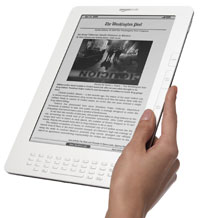
They are either the silicon-drenched saviors of books, newspapers and magazines, or yet one more reason for deep-pocketed early technology adopters to spend money.
The subject is e-book readers, and the introduction this week of Amazon’s new larger-screen Kindle DX is just the latest option in this rapidly expanding consumer electronics segment.
However, while a quick comparison may give you details on screen size, battery life and wireless vs. wired download capabilities, the current economic crisis in publishing — especially among newspapers and magazines — has many in that industry trying to read the growth in the segment as a possible happy ending for their businesses.
That may remain a fairy tale for the moment, said Peter Glasowsky, analyst for the Envisioneering Group.
“The current crop of e-book readers is very limited in what kind of reading they can really work for,” Glasowsky told TechNewsworld. “What it boils down to is all of these electronic paper-type displays are good for reading fiction, reading things that are sequential in nature. What they’re not very good at is interactive reading, because the displays are very slow and very limited in their ability to support interactive operation.”
That means limits on how much they can help struggling print publishers, who need color displays and the ability for consumers to interact with ads.
What’s Out There?
In the meantime, a quick rundown of some of the top e-book readers:
- Amazon’s Kindle: At US$489, Amazon’s new Kindle DX will be the second-priciest of the top e-book readers when it goes on sale later this summer. The larger 9.7-inch screen adds auto-rotation; the images and text can be read horizontally or vertically. Users can take advantage of 275,000 book titles and three major newspapers: The New York Times, the Washington Post and the Boston Globe.
The Kindle 2 has a 6-inch screen and sells for $359. Both Kindle 2 and the DX take advantage of Amazon’s Whispernet EVDO technology, meaning very fast wireless downloads for users. Both screens are also 16-level grayscale, and battery life is estimated at two weeks.
- Sony Reader: The Sony PRS-700 Reader, the third version of this e-book device, sells for $399 and also has a 6-inch screen, which can display eight levels of grayscale. While boasting about 7,500 pages of battery life (two weeks), the content has to be downloaded from an online Sony Connect store via a USB connection.
- iRex Iliad 2: Before the Kindle DX came along, the Iliad 2 could brag about having the largest screen among the major e-book reader brands. However, that 8.1-inch display (16-level grayscale) will also set you back $699. That makes the Iliad more of a business type of device, with content being downloaded through a WiFi connection, Bluetooth or USB. Battery life is estimated at 15 hours.
- Plastic Logic: The forthcoming Plastic Logic e-reader, set for trials in the late summer, is another device that has the attention of the publishing industry. The company Web site shows off a picture of an ultra-thin device measuring 8.5 by 11 inches, with a lot of that being the display itself.
“It has an easy gesture-based user interface and powerful software tools,” the site promises, along with access to newspapers and periodicals that can be downloaded through wireless or wired connections, and a long battery life. No price has been announced.
A Publisher’s Take
Based on her research of e-book readers, Janet Hasson said size and ease of use matter greatly. Hasson is vice president of audience development and strategy for Detroit Media Partnership, publishers of the Detroit Free Press and Detroit News.
“Our readers are telling us they they want [the newspaper] in a lot of different formats,” Hasson told TechNewsWorld. “The e-reader is not going to solve all our problems, but it’s one more distribution method on which to deliver our content. Really, our content is the most valuable thing.”
If she were designing an e-book reader that would help her industry, Hasson says she’d want the larger screen size with the ability to display color (a feature not available yet via E-ink technology) along with wireless content download capabilities.
It’s got to come as close to an actual newspaper as possible, she said. “[Readers] like the format of a newspaper, and that’s why they like an e-edition. It feels like a newspaper, they can navigate it like a newspaper. They like the column format — they like to flip the pages. And they want the advertising. Some of the e-readers have ad content and some don’t. For newspapers, that’s a critical thing. We have to have the ability to interact with advertising.”





















































I got a Sony e-reader as a Christmas gift from my brother and sister-in-law. I absolutely love it! I travel for a living and used to carry three or four books with me when I packed. With the e-reader, I carry one light-weight piece that holds all the books I want to read while on the road. It may be a one-hit wonder, but it’s number one with me. I get so many people asking me about it, that I should get commissions from Sony.
While the world is going crazy (Americans I mean),
Sorry some (Americans) I think this thing is no special device. Its a one hit wonder. I mean yet another device that does one thing. I’ll add it to all the other carp I normally carry. What I hope is that the computer manufactures are paying attention to this device and are moving to finally scale down the size of the tablet PC. The tablet is the real medium for delivering content in the future.